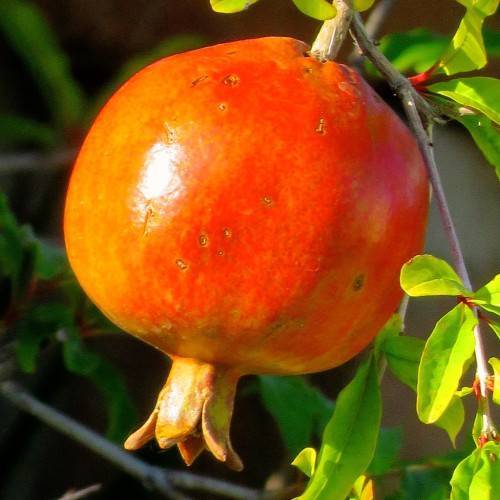
pomegranate
Punica granatum 'Wonderful'
Cycle:
Perennial
Watering:
Minimum
Hardiness Zone:
8 - 11
Flowers:
Flowers
Sun:
Full sun
Fruits:
Fruits Ready In Summer
Edible:
Yes
Leaf:
Yes
Growth Rate:
High
Maintenance:
Moderate
Salt Tolerant:
Yes
Thorny:
Yes
Care Level:
Medium
watering
Water newly-planted pomegranates deeply every 3 to 4 days for the first month. After that, water the plant once a week. During peak summer months, you may need to water it more frequently. In the winter, the frequency can be decreased. Pomegranates require deep, infrequent watering; avoid shallow, frequent watering. Too much water will cause root rot and will eventually kill the tree. Aim for the equivalent of an inch of rain every 2 weeks and monitor the soil using a soil moisture meter. The lack of water might also affect the size and sweetness of the fruit.
sunlight
Pomegranates require roughly 8 hours of sunlight per day in order to thrive. Ideally, this species prefers full sun (at least 6 hours per day with a maximum of 8 hours) and partial shade, especially in climates with high daytime temperatures. It can tolerate some light shade as well. Pomegranates can also handle some afternoon shade during the hottest months of the year. In addition, this species is wind tolerant, so great air circulation is important for its growth. For optimal health, be sure to provide as much sunshine as possible during the growing season, especially during the flowering and fruiting period.
pruning
Pruning pomegranate (Punica granatum 'Wonderful') is an important part of keeping the plant healthy and productive. For most areas, the best time to prune it is right after the harvest, in late summer or early fall. Pruning should be done judiciously, cutting away dead or sickly branches and thinning out overcrowded growth. Be sure to leave at least 2 buds per branch, and never cut more than 1-third of the branches away at a time. Doing this at least once per year will maintain size and encourage the bush to produce abundant fruit.
Season
Hardiness Map
FAQ
Do pomegranate plants require a specific type of soil?
Pomegranate plants need well-draining, loose soil with a pH between 6.0 and 8.0 for optimal growth and production. They will grow in most soil types, however, sandy or loamy soils that provide for adequate drainage of excess water are best. Adding organic material such as compost or manure to the soil helps to improve fertility and provide the nutrients the pomegranate will need for normal growth.
Are pomegranate trees self-pollinating?
No, pomegranate trees are not self-pollinating. Most varieties of pomegranate trees require the transfer of pollen between two different plants in order to produce fruit. Cross-pollination, which is necessary for the formation of pomegranate fruit, is usually performed by bees or other insects like wasps, moths, and butterflies.
Should pomegranate trees be staked for support?
Yes, pomegranate trees should be staked for support. Staking provides extra security and stability for young pomegranate trees as they are prone to being top-heavy with their large flower and fruit growth. It also helps ensure that branches are not weighed down by large fruits, which leaves the fruit more exposed to disease and pests. Additionally, staking offers circulation to the entire tree, allowing for better yield. When staking your pomegranate tree, be sure to use a stake that is strong enough to support the mature size of the tree, but also avoid using materials that will damage mature bark.
Could pomegranate plants tolerate drought conditions?
Yes, pomegranate plants can certainly tolerate drought conditions. They are native to arid parts of the Middle East, making them well-suited for hot, dry climates. Pomegranate plants have a deep root system which allows them to access deep soil moisture. They are also very drought-tolerant and can cope with long periods of heat and little water. To ensure optimal growth however, they should be provided with some watering during prolonged dry spells.
Are pomegranates resistant to deer damage?
Pomegranates are generally not considered to be resistant to deer damage. Deer may snack on the fruit itself, as well as twigs, leaves, and other vegetation near the tree. Furthermore, trees may be girdled by deer, which can significantly reduce yield. It is important to implement appropriate deer management practices to keep deer away and minimise potential damage.
Could pomegranate trees be grown as a hedge?
Yes, pomegranate trees can be grown as a hedge. Pomegranate trees are an ornamental fruit tree with dense, evergreen foliage that can be clipped from a young age and shaped into a hedge. Not only are the pomegranate bushes dense, but they can also produce edible fruit when fully mature. Pomegranate hedges need full sun exposure and regular watering, as well as pruning during the growing season and fertilizing two times per year in order to thrive.
Should pomegranate trees be mulched?
Yes, pomegranate trees should be mulched. Mulching helps protect the roots of the tree from extreme temperatures, conserves moisture, reduces the growth of weeds, and improves the soil aeration. It can also help break down the organic matter in the soil, which in turn helps the tree to access necessary nutrients. Apply a 2-3 inch layer of mulch, making sure to keep it away from the trunk of the tree. The mulch should be reapplied annually in the spring to help maintain the benefits.
Are pomegranate trees affected by air pollution?
Yes, pomegranate trees are affected by air pollution. This is because air pollution has been linked to a decrease in plant biomass, nutrient availability, photosynthesis, and overall plant health. Additionally, studies have found that pollutants such as sulfuric dioxide and nitrogen dioxide can decrease a pomegranate tree's transpiration rates, causing its leaves to become dry and brittle. These pollution-related problems can lead to decreased yields and decreased fruit production, making it difficult for farmers to produce healthy, edible pomegranates.
